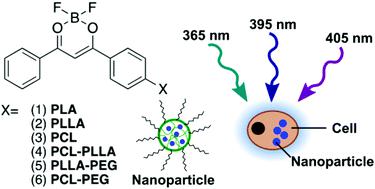当前位置:
X-MOL 学术
›
Biomater. Sci.
›
论文详情
Our official English website, www.x-mol.net, welcomes your feedback! (Note: you will need to create a separate account there.)
Labelling primary immune cells using bright blue fluorescent nanoparticles.
Biomaterials Science ( IF 6.6 ) Pub Date : 2020-02-06 , DOI: 10.1039/c9bm01572h Maura C Belanger 1 , Meng Zhuang 2 , Alexander G Ball 3 , Kristen H Richey 2 , Christopher A DeRosa 2 , Cassandra L Fraser 2 , Rebecca R Pompano 1
Biomaterials Science ( IF 6.6 ) Pub Date : 2020-02-06 , DOI: 10.1039/c9bm01572h Maura C Belanger 1 , Meng Zhuang 2 , Alexander G Ball 3 , Kristen H Richey 2 , Christopher A DeRosa 2 , Cassandra L Fraser 2 , Rebecca R Pompano 1
Affiliation

|
Tracking cell movements is an important aspect of many biological studies. Reagents for cell tracking must not alter the biological state of the cell and must be bright enough to be visualized above background autofluorescence, a particular concern when imaging in tissue. Currently there are few reagents compatible with standard UV excitation filter sets (e.g. DAPI) that fulfill those requirements, despite the development of many dyes optimized for violet excitation (405 nm). A family of boron-based fluorescent dyes, difluoroboron β-diketonates, has previously served as bio-imaging reagents with UV excitation, offering high quantum yields and wide excitation peaks. In this study, we investigated the use of one such dye as a potential cell tracking reagent. A library of difluoroboron dibenzoylmethane (BF2dbm) conjugates were synthesized with biocompatible polymers including: poly(l-lactic acid) (PLLA), poly(ε-caprolactone) (PCL), and block copolymers with poly(ethylene glycol) (PEG). Dye-polymer conjugates were fabricated into nanoparticles, which were stable for a week at 37 °C in water and cell culture media, but quickly aggregated in saline. Nanoparticles were used to label primary splenocytes; phagocytic cell types were more effectively labelled. Labelling with nanoparticles did not affect cellular viability, nor basic immune responses. Labelled cells were more easily distinguished when imaged on a live tissue background than those labelled with a commercially available UV-excitable cytoplasmic labelling reagent. The high efficiency in terms of both fluorescence and cellular labelling may allow these nanoparticles to act as a short-term cell labelling strategy while wide excitation peaks offer utility across imaging and analysis platforms.
中文翻译:

使用明亮的蓝色荧光纳米粒子标记原代免疫细胞。
跟踪细胞运动是许多生物学研究的重要方面。用于细胞跟踪的试剂不得改变细胞的生物学状态,并且必须足够亮以在背景自发荧光之上可视化,这在组织成像时尤为重要。尽管开发了许多优化用于紫光激发(405 nm)的染料,但目前几乎没有与标准UV激发滤光片组(例如DAPI)兼容的试剂可以满足那些要求。硼基荧光染料家族,即二氟硼β-二酮酸酯,以前曾用作具有UV激发的生物成像试剂,具有高量子产率和宽激发峰。在这项研究中,我们调查了一种这样的染料作为潜在的细胞跟踪试剂的用途。用生物相容性聚合物合成了二氟硼二苯甲酰甲烷(BF2dbm)共轭物的文库,这些聚合物包括:聚(1-乳酸)(PLLA),聚(ε-己内酯)(PCL)和与聚(乙二醇)(PEG)的嵌段共聚物。将染料-聚合物共轭物制成纳米粒子,该纳米粒子在37°C的水中和细胞培养基中稳定一周,但在盐水中迅速聚集。纳米颗粒用于标记原代脾细胞。吞噬细胞类型被更有效地标记。用纳米颗粒标记不影响细胞生存力,也不影响基本免疫反应。当在活体组织背景上成像时,标记的细胞比那些用市售紫外线可激发的细胞质标记试剂标记的细胞更容易区分。
更新日期:2020-02-06
中文翻译:

使用明亮的蓝色荧光纳米粒子标记原代免疫细胞。
跟踪细胞运动是许多生物学研究的重要方面。用于细胞跟踪的试剂不得改变细胞的生物学状态,并且必须足够亮以在背景自发荧光之上可视化,这在组织成像时尤为重要。尽管开发了许多优化用于紫光激发(405 nm)的染料,但目前几乎没有与标准UV激发滤光片组(例如DAPI)兼容的试剂可以满足那些要求。硼基荧光染料家族,即二氟硼β-二酮酸酯,以前曾用作具有UV激发的生物成像试剂,具有高量子产率和宽激发峰。在这项研究中,我们调查了一种这样的染料作为潜在的细胞跟踪试剂的用途。用生物相容性聚合物合成了二氟硼二苯甲酰甲烷(BF2dbm)共轭物的文库,这些聚合物包括:聚(1-乳酸)(PLLA),聚(ε-己内酯)(PCL)和与聚(乙二醇)(PEG)的嵌段共聚物。将染料-聚合物共轭物制成纳米粒子,该纳米粒子在37°C的水中和细胞培养基中稳定一周,但在盐水中迅速聚集。纳米颗粒用于标记原代脾细胞。吞噬细胞类型被更有效地标记。用纳米颗粒标记不影响细胞生存力,也不影响基本免疫反应。当在活体组织背景上成像时,标记的细胞比那些用市售紫外线可激发的细胞质标记试剂标记的细胞更容易区分。



























 京公网安备 11010802027423号
京公网安备 11010802027423号